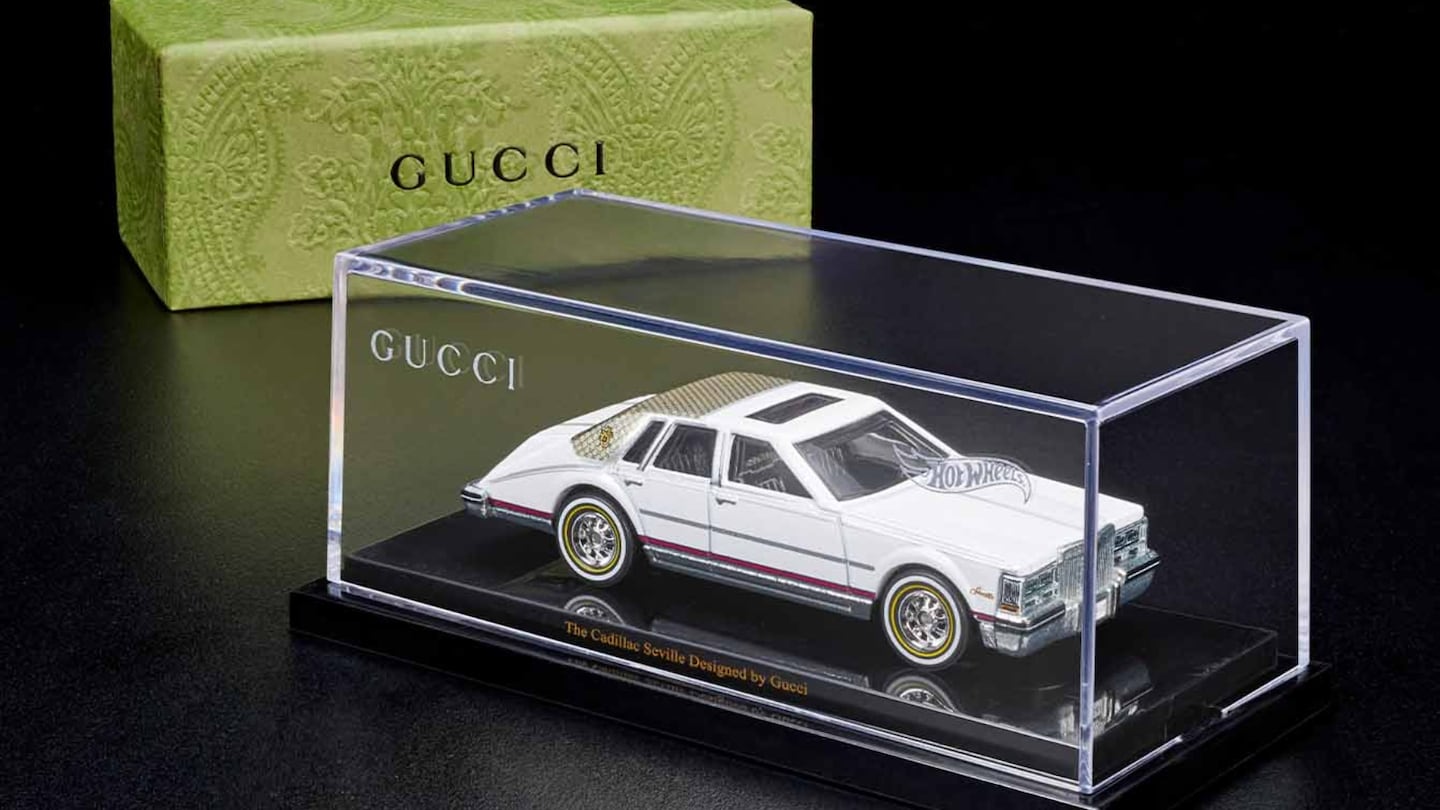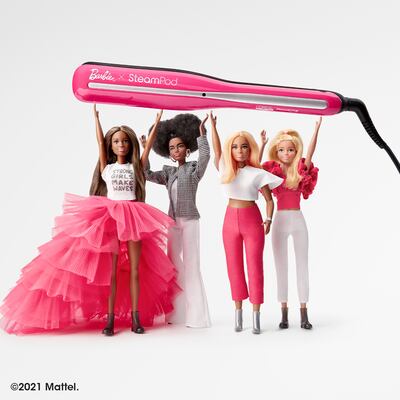
The Business of Fashion
Agenda-setting intelligence, analysis and advice for the global fashion community.

Agenda-setting intelligence, analysis and advice for the global fashion community.

Gucci’s latest sell-out product wasn’t a belt, or a bag, or a pair of shoes. It wasn’t, in fact, a fashion item at all. It was a toy car.
The car, a miniature version of the 1982 Cadillac Seville decked out with a Gucci logo-printed roof, cost $120 and was result of a collaboration between the Italian luxury label in honour of its centennial and Hot Wheels, the Mattel-owned toy car brand. The item, of which just 5,000 were made, sold out in four minutes, and is now available on resale platforms like StockX for as much as $500.
The Hot Wheels tie-up with Gucci is just one of the latest crossovers between the fashion and beauty worlds with the toy industry. In the past month, American Girl, best known for its history-themed dolls and corresponding books, has launched three fashion-focused collaborations. It partnered with designer Prabal Gurung for his Spring/Summer 2022 show, with Harlem’s Fashion Row and designer Carly Cushnie to create “modern” versions of the historical dolls’ outfits, and with Stoney Clover Lane to roll out a line of accessories. Card game Uno has debuted special decks in partnership with streetwear label Bape, as well as Justin Bieber’s clothing line Drew House. On Nov. 17, toy company MGA will unveil a collaboration with Puma for its LOL Doll brand. Last year, Lego unveiled collaborations with both Adidas and Levi’s, while in 2019, Gucci teamed up with Disney to create a line of Mickey Mouse-covered bags and apparel. It’s happening in beauty, too: L’Oréal Professionel debuted a Barbie-branded version of its L’Oréal Professionnel Steampod styling tool this month, while MGA teamed up with Revolution Beauty for a Bratz cosmetics line.
The toy industry’s primary demographic may be children, but that isn’t the target consumer for fashion and beauty brands. Instead, they are aiming to tap into nostalgia by teaming up with beloved toy brands that carry positive childhood associations for adult consumers, while it’s an opportunity for toy brands to embed their products into the cultural zeitgeist. As well, it’s an opportunity for fashion brands to tap into an industry that not only is robust — last year, the toy industry in the US was worth approximately $32.6 billion, according to data from the NPD Group — but also has loyal fans.
ADVERTISEMENT
“Partnerships in fashion, art and entertainment really have become a shining example of how we’re keeping our brands relevant,” said Richard Dickson, president and chief operating officer at Mattel. “Our brands run generations — 40, 50, 60 or 70 years old. Keeping these brands relevant is a really important part of the marketing methodology.”
The Power of Nostalgia
Nothing stirs nostalgia quite like the things people associate with childhood, and in today’s climate, when headlines and current events can feel heavy, it’s a particularly effective tool for brands to tap into.
“After the last year we’ve had, people just want to feel good and feel like their younger self,” said Kendall Glazer, co-founder of DTC accessories brand Stoney Clover Lane. “They want to be reminded of what made them happy or what made them smile [as a kid] and tap into that.”

Brands have increasingly been turning to beloved pop culture pieces for inspiration, with positive results. Just look at Balenciaga’s branded episode of “The Simpsons” produced with the cartoon’s creator Matt Groening. Premiered at the autumn Paris Fashion Week, the episode became one of the event’s most-talked-about moments, with rapturous applause from the audience as “The Simpson” patriarch and his family strolled down a runway sporting Balenciaga’s latest looks.
“When you want to have a collaboration, in general, but especially with a brand, you’re trying to reach out to the emotions and the hearts of people you don’t actually know,” said Anne Machet, international general manager at L’Oréal Professional Paris.
Glazer said that at Stoney Clover Lane, which has collaborated with Barbie as well as Disney and Sanrio’s Hello Kitty, it’s about creating items that capture the essence of favourite childhood brands but are packaged in a way that would appeal and be useful to adults. In Stoney Clover Lane’s case, its American Girl collaboration came in the form of the brand’s pouches and bags featuring the signature prints for each of the six original American Girl dolls.
“I wanted something for me, a 30-year-old who loved American Girl, who walks through the store and is so nostalgic,” she said. “It’s not for your daughter; it’s for me.”
ADVERTISEMENT
Creating a Moment
For both parties, the aim is to also create a cultural moment, beyond just a collectable item, and perhaps spurs conversation — a big driver in any brand collaboration, whether it’s American Girl and Prabal Gurung or Fendi and Skims.
“When you can find that nostalgic trend with a relevant narrative that appeals to adults today, it creates a magical moment where collectability and fun converge,” said Dickson. “Toys are literally a canvas for fashion brands and culture to be reflected.”
The convergence of the two industries is also, perhaps, less unexpected than it may seem. “The toy industry has always been a fashion industry itself, trends come and go and come back again years later with a new twist or flair or something like that,” said Jackie Breyer, editorial director of website The Toy Insider.

Despite the consumer affinity, an impactful moment can only happen if a collaboration feels true to both brands’ ethos. “It can’t just be a brand slapped on a shirt,” said Breyer. “You can’t just take a picture of Hot Wheels, put it on a T-shirt and expect adults to get excited about it.”
To give special attention to these partnerships, Mattel in 2020 launched Mattel Creations, a division dedicated to creating limited-edition capsule collections and collaborations, with not just fashion brands, but also entertainment companies and artists. The partnerships, Dickson said, are borne out of mutual interest and a consideration of how the collaboration would work within the brand’s overall positioning and purpose. Gucci and Hot Wheels, he said, made sense because both brands have extremely loyal fanbases, and the collaboration could bring the two bases together. Mattel is increasingly approached by brands interested in working with them. (Gucci, for example, approached Mattel, said Dickson.)
And while a limited run of Gucci’s $120 Hot Wheels cars isn’t likely to make a meaningful difference in either brand’s balance sheet, Dickson believes there is potential for these collaborations to move the needle financially. A Hot Wheels collaboration with watch label IWC Schaffhausen sold at auction for $96,000 — a sign, perhaps, of why such collaborations may be increasingly enticing.
“Initially what is perceived to be a great, culturally relevant, buzzy, fun way for fashion brands to play is going to start to become an actual business that fashion will look at as incremental opportunity,” said Dickson.
ADVERTISEMENT
And the performance of several of these collections demonstrates consumer interest. Similar to the near-instantaneous sell-out of Gucci’s Hot Wheels collaboration, the entirety of Stoney Clover Lane’s American Girl collection was snapped up within minutes.
“I was surprised at how brilliantly the classic American Girl prints translated into other products,” said influencer Carly Riordan. “Makes me wish they’d do even more.”
Related Articles
Gucci Is Selling $12 (Virtual) Sneakers
Macy’s Is Reviving Toys ‘R’ Us
Netflix and Shonda Rhimes Test Fashion Opportunity With Bridgerton Collabs
The British musician will collaborate with the Swiss brand on a collection of training apparel, and will serve as the face of their first collection to be released in August.
Designer brands including Gucci and Anya Hindmarch have been left millions of pounds out of pocket and some customers will not get refunds after the online fashion site collapsed owing more than £210m last month.
Antitrust enforcers said Tapestry’s acquisition of Capri would raise prices on handbags and accessories in the affordable luxury sector, harming consumers.
As a push to maximise sales of its popular Samba model starts to weigh on its desirability, the German sportswear giant is betting on other retro sneaker styles to tap surging demand for the 1980s ‘Terrace’ look. But fashion cycles come and go, cautions Andrea Felsted.